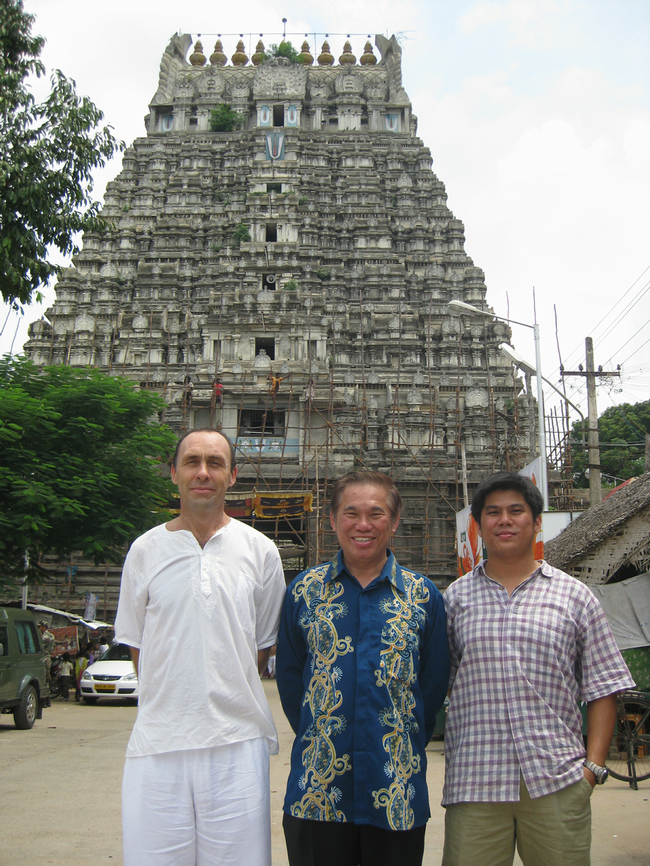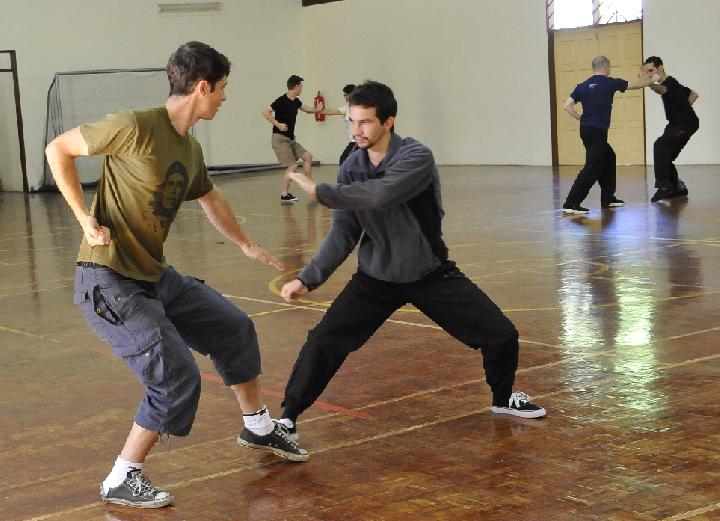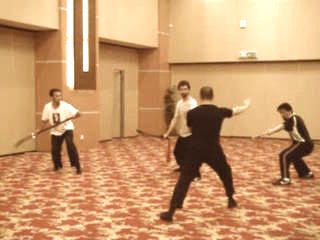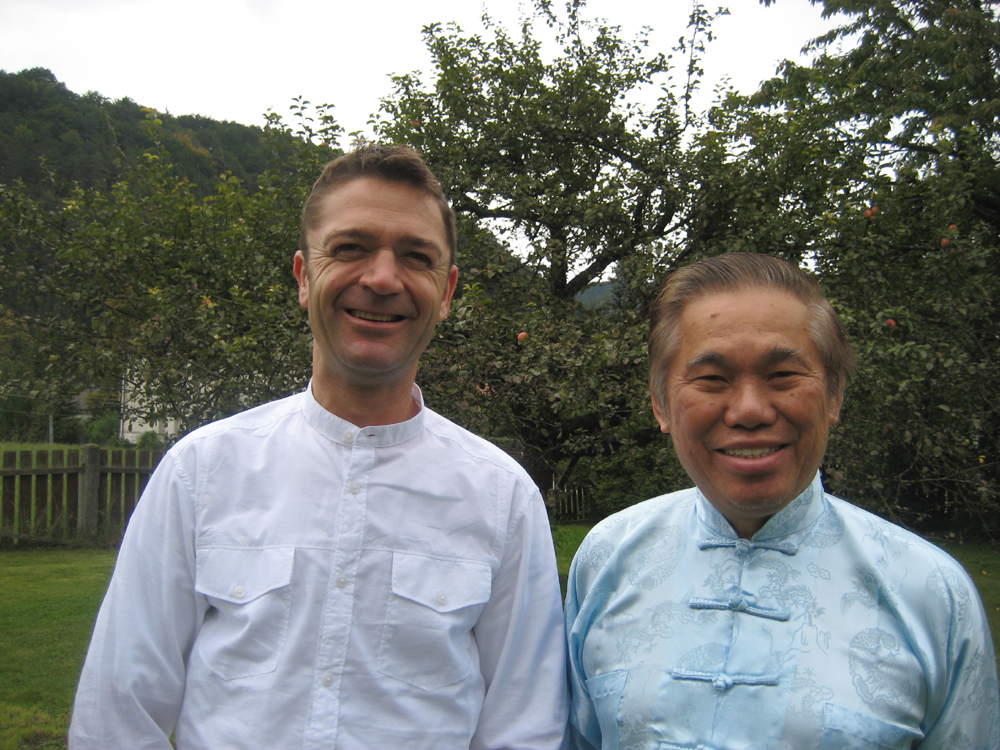SELECTION OF QUESTIONS AND ANSWERS
OCTOBER 2011 PART 1

Sifu Rama, Granmaster Wong and Sifu Wong Chun Nga in Kanchipuram, India, the birthplace of our First Patriarch Bodhidharma
Question 1
Sifuji, many students have wondered how you could speak so clearly and for a long time yet without losing your voice or having a soar throat. Could you explain how you could do this?
— Sifu Rama Roberto, Costa Rica
Answer
Relax your vocal cords and let your voice come from your dan tian. Let your energy flow through the vocal cords. Just let it flow.
People become hoarse from speaking when they tense their vocal cords. They cannot speak loudly because their voice comes from their throat instead of from their dan tian.
It is like any other physical activities. If you relax your muscles and let your energy flow from your dan tian to do its work, you won't become tired. When we are relaxed, physically and mentally, the energy flowing out from the dan tian will be naturally replenished by energy flowing in from the Cosmos.
Interestingly, this is what happens when our students spar for hours in Taijiquan and Shaolin Kungfu. I haven't thought of it before but your question helps me to draw a connection between speaking and sparring for a long time without feeling tired or feeling out of breath. Both feats as well as other physical activities can be achieved if we relax ourselves and let energy flow from our dan tian to do the work.
It can also be applied to mental activities. When we are relaxed and let our energy flow to do our thinking, we won't be tired easily.
Question 2
How do we know we are practicing correctly?
— Santiago, Ecuador
Answer
An excellent way is to compare our result with the result that exercise or art is purported to give.
If exercise or art X is purported to give result A, B, C, and you get A, B, C, then you have been practicing correctly. If you get P, Q, R, you have not been practicing correctly. For example, performing "Double Hooks" from the Eighteen-Lohan Art is supposed to give you some internal force. If you feel some internal force after practicing it, you have been practicing correctly. If you feel tensed or empty, then your practice has been wrong.
The fault can be traced to one, two or all of the following three factors: the art, the teacher and the student. If the art is not genuine, of course you will not get the result the genuine art will give. If the teacher is not competent, you may not get the result even when the art is genuine. If you are a bad student, you may not get the result even when the art is genuine and the teacher is competent.
Failing to appreciate this simple truth results in many people not getting the result they want as well as wasting a lot of time, in a matter of years. Chi kung is purported to give good health and vitality, yet a lot of chi kung practitioners still remain sick and weak. Taijiquan is an internal martial art, yet a lot of Taiji practitioners have no internal force and they cannot defend themselves.
The situation is worse in external martial arts. The two main aims of practicing any martial art is to be healthy and be able to defend themselves. Yet a lot of martial artists are becoming more and more unhealthy the more they train, and they also cannot defend themselves, otherwise they would not sustain a lot of punches and kicks in their sparring.

An excellent way to tell whether one is practicing any art correctly is to access his result with what the art is purported to give. For example, practicing kungfu enables a practitioner to apply kungfu for combat. If he can't, there is good reason to suspect whether he has been practicing kungfu correctly.
Question 3
I sincerely apologize for calling you "Sifu" when I should call you "Sigung". Please forgive my disrespectfulness.
— Csaba, Canada
Answer
You were not wrong to call me "Sifu" earlier. In fact it was respectful of you.
"Sifu" or "Sifu" followed by the master's surname or name is the polite term the general public address a master. As my surname is "Wong", people in general politely address me as "Sifu Wong". Some shorten the term to just "Sifu".
But members of our Shaolin Wahnam Family address me according to from whom they first learned. If they learn from me, they call me "Sifu". If they learn from my student, they call me "Sigung". If they learn from a student of my student, they call me "Sitaigung".
Question 4
I was wondering if it was easier to buy books through you via mail and money order, or would it be better to order via Amazon books. I have interest in all of your books but at the moment I have great interest in two out of your wonderful books. One is on Chi Kung and the other on Zen. The reason is that as a beginner to Shaolin Wahnam, Zen and Chi go together hand in hand. I stand to be corrected but Zen first and Chi after.
Answer
It is better to order via Amazon Books. I don't have the books with me.
I am much impressed with your observation.
Yes, Zen and chi go hand in hand in our school. That is why when we practice Shaolin Kungfu or Wahnam Taijiquan, we are at the same time practicing meditation and chi kung.
You are also right to say that Zen comes first, chi after. In all my courses, we always start with entering into a heightened state of mind. In chi kung classes we call it entering into a chi kung state of mind. In Shaolin classes we call it entering Zen. In Taijiquan classes we call it entering Tao. Entering into this heightened state of mind right at the beginning of every class enhances the result of the training tremendously.

Good kungfu demands much mental clarity, especially when you are unarmed against multiple armed opponents, like what Sifu Tim Franklin did during an Advanced Shaolin-Taijiquan Course in Penang.
Question 5
My previous masters and I noticed that most of the time those who practiced Zen were usually the best at forms and sparring. I was always good at sparring. The reason was because of Zen training. It is much easier to pick up little nuances that affect the training of a student if he or she practices Zen. It is also easier to pick up mistakes.
Answer
Again, I am impressed with your observation. A main reason why we in Shaolin Waham can get a lot of benefits in a relatively short time is in no doubt due to our Zen training.
Not many martial artists today realize the importance of Zen training. They usually pay much attention to power and techniques, but little attention to mental clarity. Indeed, if you observe them spar, it is evident they lack the mental clarity to realize that many of their movements place them at great risks. Mental clarity, of course, is a result of Zen training.
Question 6
I have noticed an improvement with my life just from Smiling from the Heart. What were stressful situations are now not stressful or not as stressful. Negative situations are no longer negative. I look at things more positively. I am much happier. I have always strived to achieve greater virtues. Smiling from the Heart allows me to advance to the next level of patience and virtue.
Answer
I am very glad of your result.
Many students in our school regard "Smiling from the Heart" the best benefit they get from our teaching. Indeed, even if you had no other benefits learning from us but you become happier, you have spent your time well.
There are two ways of looking at anything -- the negative way and the Shaolin Wahnam way. I am glad you have learnt the Shaolin Wahnam way so quickly.
We place great importance on virtues. Our Ten Shaolin Laws are a practical guide to virtuous living.

Smiling from the heart, as shown here by Ulrich and Grandmaster Wong, is regarded my many as the best benefit from Shaolin Wahnam
Question 7
Is there a limit to how much internal force one can develop?
— Sifu Eugene Siterman, USA
Answer
No, there is no limit.
This should not be confused with over-training. Irrespective of how much or little internal force a person has, over-training is harmful to him. Over-training is having more force than his physical body can take. Having no limit to developing internal force means he can keep on increasing his internal force as long as his physical body is given sufficient time to adjust to the increase.
The physical body is represented by yin, and internal force (or energy) is represented by yang. At any one time, yin or yang may be slightly more or less than the other, but so long as they are in balance on a whole, it is fine. Suppose a practitioner starts with 500,000 units of yin, and 500,000 units of yang. His physical body and his internal force are in balance.
By practicing an internal force training method he increases his yang by 100 units. Now he has 500,000 units of yin, and 500,100 units of yang. This is alright because the increase of yang is not much. His body will adjust itself, without him having to do anything, and after some time he will have 500,050 units of yin and 500,050 units of yang. Some of his yang is used to enhance his yin, like replacing unhealthy cells in his body.
If the increase of internal force at one training session is too much, the body may not be able to adjust in time. For example, if yang increases to 501,000 units with yin at 500,000 units, it would be over-training. If over-training continues for some time, harm will result.
If yang increases gradually and consistently, giving sufficient time for his yin to adjust, eventually the practitioner will have 1,000,000 units of yin and 1,000,000 of yang. He will have twice the amount of internal force than before. Will his body also be twice as big? No, his body does not necessarily increase in size, but in efficiency. His body will be twice as resilient. There is no limit to the increase of his internal force.
Question 8
What will happen if his internal force increases infinitum?
Answer
At the supreme level his internal force helps him to break through his illusionary body to attain Enlightenment, or Return to God the Holy Spirit.
At relatively lower levels, but still very high compared to what most people experience, his internal force helps him to attain spiritual awakening, like some of our students have experienced.
Spiritual cultivation requires a lot of internal force. This explains why we have so many wonderful spiritual experiences in our classes, because we develop a lot of internal force. At the Cosmic Breathing class (28th February 2011 on the Blue Mountain), for example, more than half the class of 30 students experienced their spirit expanded beyond their physical body. This was amazing, and unbelievable to other people.
In principle, spiritual cultivators practicing sitting meditation do the same thing. They relax totally and think of nothing. As a result they also develop internal force. But the internal force developed is little, and they are usually unaware of it. If they continue to practice for a long time, the accumulated internal force may be powerful enough to enable their spirit to break through their illusionary body or to have other spiritual experiences.
LINKS
Selected Reading
- Ten Essentials of Taijiquan
- Revealing the Secrets of the Twelve Bridges of the Famous Iron-Wire Set
- First Shaolin Wahnam Standardized Test in the 1980s
- Dublin is Good for You
- How do Masters Spar?
